
Coincidences in Science May Lead to Huge Discoveries
He was part of the team which developed functional Magnetic Resonance Imaging in 1992 and revolutionized our understand of the brain. Professor Kamil Uğurbil has been a scientist long enough to speak confidently about the influence of multidisciplinary study, why coincidences sometimes present unmissable opportunities for discovery, and how the scientific community around him fed his research.
Kamil Uğurbil is Director of the University of Minnesota Centre for Magnetic Resonance Research and holds the McKnight Presidential Endowed Chair Professorship in Radiology, Neurosciences and Medicine. Also winner of the 2016 Vehbi Koç Award, Professor Uğurbil was among the guests at Koç University’s 25th Anniversary Celebrations where he spoke at a College of Sciences seminar. We met with Professor Uğurbil and talked about many subjects including how they grabbed a slice of history with their ground breaking discovery and what shaped his journey to becoming a sophisticated scientist.
You were one of the pioneers in developing ground-breaking brain research techniques such as fMRI (functional Magnetic Resonance Imaging). First off, congratulations! Tell us the story behind this discovery. How did you begin? What kind of team did you work with?
After finishing my PhD I joined Bell Laboratories. It was an amazing laboratory for that time and with many Nobel laureate scientists working there. Although it was essentially a telephone company’s (AT&T) laboratory, it had a very open-minded working environment similar to a university’s. When I say telephone laboratory you might think everyone was working with phones. But as I said, it was a very open-minded setting and valued, for instance, biology very highly. The reason behind this is that a telephone company’s job is to carry information. As a molecule, DNA carries the most information and the most interesting information. So it’s natural for a telephone company to want to explore this. We were a small biophysics group seeking ways to understand what’s going on inside a cell without tearing it apart. Before, the only way to explore the machinery of cells was to break them apart. It was like demolishing a building then figuring out its structure and function from the rubble. Our group, however, wanted to study the cell while it is still intact. This work eventually progressed in different directions. For example, I began studying the heart – I was interested in the heart, but not because I wanted to become a cardiologist. Suppose that you cut out a mouse’s heart. If you connect it to certain tubes it will continue to function. This was a very interesting model for me. The heart was a convenient model to investigate how the cell produces energy by using magnetic resonance and how this energy is used. The work our team did, in summary, was using magnetic resonance to figure out what was going on in a cell.
One of our colleagues encountered a strange phenomenon while working with magnetic resonance on mice brains. At that time we were using small magnets. After accidentally placing the mouse upside down in the container with the magnet, he took images of the mouse’s brain and noticed some differences in the images. He realised the images were different because the mouse was deprived of oxygen, so he increased the oxygen level causing other differences in the images. This was an accident.
Some big discoveries are said to have resulted from such accidents or ‘happy coincidences’.
Sometimes accidents offer you new insights, as it did in that case. A friend of mine, Seiji Ogawa, wondered why the images were changing further. He performed experiments on the brain and saw that the brain’s deprivation of oxygen leads to an increase in deoxyhaemoglobin. This is a highly magnetic molecule and can disrupt imaging with the help of a small magnet. Seiji called this mechanism BOLD (Blood Oxygen Level Dependent Contrast Imaging). I was also interested in this research because at the time I was working on energy metabolism. Meanwhile, it was possible to image changes and activities within the brain via PET (Positron Emission Tomography) but PET was not able to measure direct neuronal activity. Nonetheless, neuron activity increased blood flow and it was certainly possible to measure that. Despite the increase in blood flow, other research showed that oxygen use did not change significantly. So, we said ‘the images of these blood vessels should change. Let’s see if we can use this and measure it with magnetic resonance’. At that time I was a member of a 4 Tesla magnet project because my studies had move on to humans. This was the magnet which we wanted to use to conduct the experiment. We waited a long time for it to arrive. The first experiment we did was to try and achieve fMRI by using that mechanism. That magnet was not a simple gadget you could operate by pushing a button. It was highly experimental so there were a lot to improve. For that reason, the experiments progressed slowly. But then we learned that MGH (Massachusetts General Hospital) was also working on this process. Neither of the groups had any idea what the other was doing, whether they succeeded or not… In the end, both groups published in the same journal, PNAS. Both laboratories submitted their studies to the journal within five days of each other. We were late because we had initially sent the study to Nature, one of two journals regarded as having the highest impact. They rejected us resulting in a delay of about a month.
Did this competition change the pace of your research?
Yes, of course, competition is a good thing and one way or another it increased the pace. But we didn’t know what the other group was doing until the last minute. We’d wanted to do this experiment for a very long time but we didn’t have that 4 Tesla magnet. We waited for the magnet for almost four years with no idea another group was working on the same subject.
We now know that fMRI is a ground-breaking technique with countless benefits. What do you think the greatest benefit of your experiment was?
When we talk about the benefits of something people usually think of medical benefits. It did benefit medicine, but not greatly. Medical doctors use fMRI during brain surgery, to image the brain and plan the surgery before the actual operation. However, its greatest benefit has been in becoming the most commonly used technique to study how the human brain works. Indeed, if we look at the pre-fMRI period and compare it with today, we can see there has been a considerable increase in the amount of new information and discoveries related to the human brain. There is still a long way to go and lot more to learn using this technique. Returning to medicine, I believe it will become a crucial technique in neuropsychiatry. It will be very effective in both understanding diseases and enabling the necessary medical interventions.
You were also involved in setting the goals for the BRAIN (Brain Research through Advancing Innovative Neurotechnologies) Initiative. What are the main objectives of this project, and (although still early days) can you say it has been successful so far? How would you qualify it?
I think it’s a very successful project. Investment in brain research is increasing, especially in the US. When the project began our idea was that we need technology to make new discoveries. In the US, brain research annually receives about 7 billion USD. When we consider overall global funding the share devoted to the BRAIN Initiative seems small. The project mainly aims to improve technology in brain studies. Several laboratories have received funds from the project to work on specific technologies. There hasn’t been a major discovery yet, but we can say that a very exciting process is going on. It will implicitly affect many processes.
You work in many fields including physics, medicine and neurology. Did these interdisciplinary studies broaden your horizons as a scientist? Would you advise young scientists to diversify their areas of interest?
Of course, I highly recommend it. In the past, a physicist dealt with physics, a chemist with chemistry, and everyone worked in their own fields. Nowadays, especially in research related to biology, interdisciplinary studies are crucial. For example, we talked about fMRI, which is absolutely an invention requiring physicists with knowledge of biology. It wouldn’t be possible otherwise. First, you need to know about the principles of nuclear magnetic resonance. This is the work of a physicist. Then you need to have some knowledge of physiology, biology, and neurology. This was entirely an interdisciplinary work, and an invention which could only be made by people like me, coming from a physics background and developing an interest in biology. Of course, other combinations are also possible, such as an expert in molecular biology who begins working in neurology and the brain. But generally, interdisciplinary studies are very important today. I may as well attribute my success in science to this.
What advice would you give young scientists in helping them transform ideas into revolutionary new technologies?
This is not an easy question to answer. First and foremost, I think planning big discoveries is a challenging task. Your environment is very important. Why did so many inventions and substantial theories come out of Bell Labs? Everyone wants to know the secret of Bell Labs to create a similar laboratory or university. I think it only has one secret: putting intelligent people who are interested in science together in one place. One day you are having a conversation with someone during coffee break. The next thing you know, an important collaboration emerges sprouting all kinds of new ideas. Lunchtime at Bell Labs was amazing: no one ate alone in their rooms, we always ate lunch together in the cafeteria. Being scientists from different disciplines we talked about all kinds of subjects. One subject led to another without us even realizing, leading to previously unimaginable ideas. Consequently, your environment, the culture, and the air you breathe are all very important.

